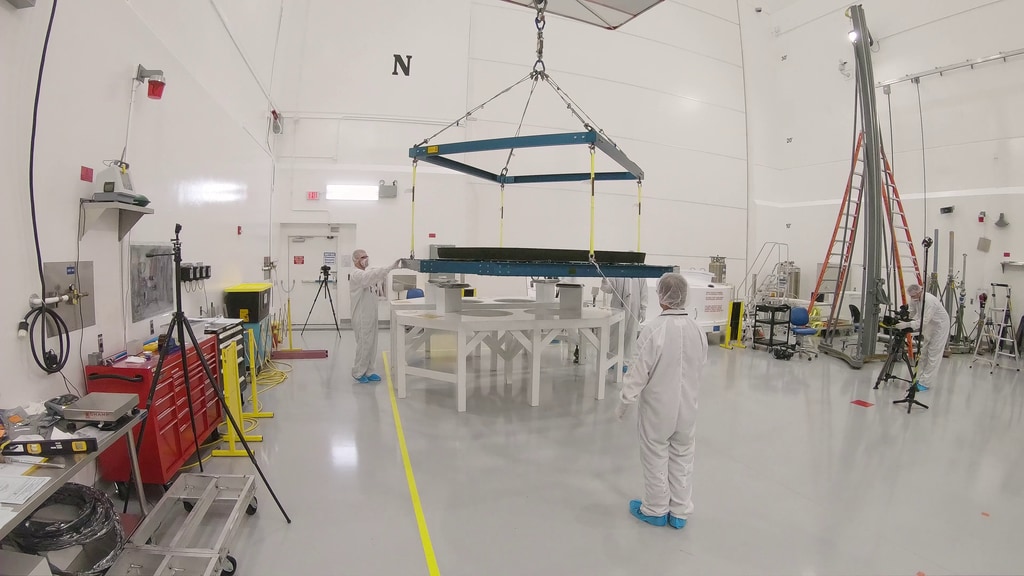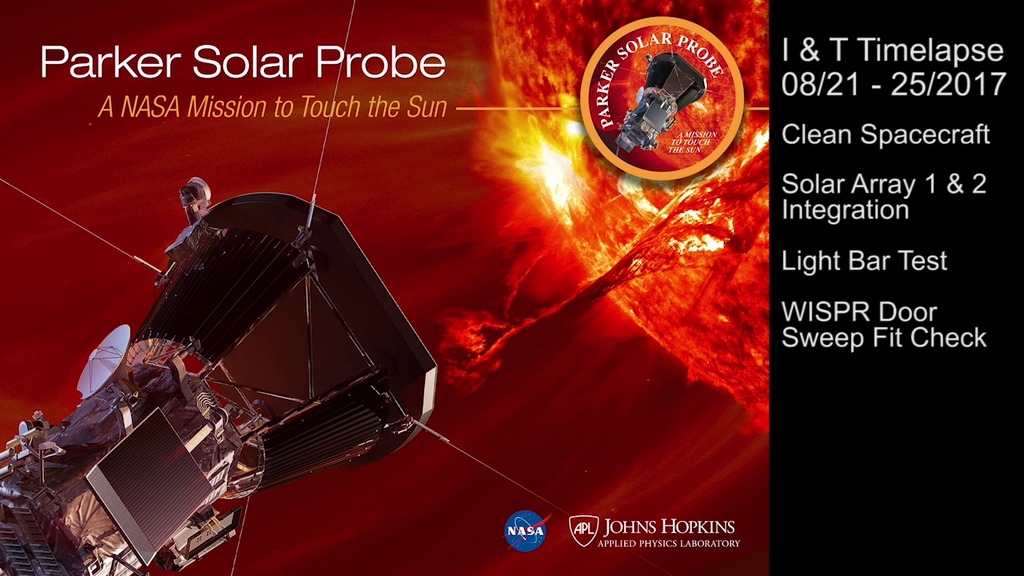Parker Solar Probe Travels to Florida
Parker Solar Probe Arrives in Florida
On April 4, 2018, Parker Solar Probe project scientist Nicky Fox of Johns Hopkins APL describes the spacecraft's April 3 journey to Florida and arrival at Astrotech Space Operations, the probe's new home before a scheduled launch on July 31, 2018 from NASA's Kennedy Space Center.
Credit: NASA/Johns Hopkins APL/Lee Hobson
Watch this video on the Johns Hopkins APL YouTube channel.
NASA's Parker Solar Probe is shown in its protective shipping container during transport from Goddard Space Flight Center in Greenbelt, Maryland - where it underwent space environment testing - to Joint Base Andrews, Maryland on April 2. Once at Joint Base Andrews, the spacecraft was loaded aboard a United States Air Force C-17 cargo plane for a flight to Space Coast Regional Airport in Titusville, Florida on April 3. After landing, the spacecraft was unloaded and taken to Astrotech Space Operations in Titusville, where it will continue testing and pre-launch processing. Parker Solar Probe is scheduled to launch no earlier than July 31 from NASA's Kennedy Space Center in Florida.
Credit: NASA/Johns Hopkins APL/Lee Hobson
NASA's Parker Solar Probe is shown in its protective shipping container during transport from Goddard Space Flight Center in Greenbelt, Maryland - where it underwent space environment testing - to Joint Base Andrews, Maryland on April 2. Once at Joint Base Andrews, the spacecraft was loaded aboard a United States Air Force C-17 cargo plane for a flight to Space Coast Regional Airport in Titusville, Florida on April 3. After landing, the spacecraft was unloaded and taken to Astrotech Space Operations in Titusville, where it will continue testing and pre-launch processing. Parker Solar Probe is scheduled to launch no earlier than July 31 from NASA's Kennedy Space Center in Florida.
Credit: NASA/Johns Hopkins APL/Lee Hobson

Parker Solar Probe – wrapped in protective plastic – is shown on March 29, 2018, as the lid is lowered onto its shipping container at NASA’s Goddard Space Flight Center in Greenbelt, Maryland. The spacecraft is shipped on its side to allow for more easy transport and to avoid height-related obstacles such as bridges. From Goddard, the probe was taken by truck to Joint Base Andrews in Maryland and flown to Florida aboard a United States Air Force C-17.
Credit: NASA/Johns Hopkins APL/Ed Whitman

Inside its protective shipping container, NASA’s Parker Solar Probe is loaded into a C-17 from the United States Air Force’s 436th Airlift Wing at Joint Base Andrews in Maryland in the early morning of April 3, 2018. From Joint Base Andrews, the spacecraft was flown to Titusville, Florida, where it was taken to Astrotech Space Operations for pre-launch testing and preparations.
Credit: NASA/Johns Hopkins APL/Jeffrey Fiske

NASA’s Parker Solar Probe, inside a protective shipping container, is loaded into a C-17 from the United States Air Force’s 436th Airlift Wing at Joint Base Andrews in Maryland in the early morning of April 3, 2018. From Joint Base Andrews, the spacecraft was flown to Titusville, Florida, where it was taken to Astrotech Space Operations for pre-launch testing and preparations.
Credit: NASA/Johns Hopkins APL/Jeffrey Fiske

NASA’s Parker Solar Probe, inside a protective shipping container, is loaded into a C-17 from the United States Air Force’s 436th Airlift Wing at Joint Base Andrews in Maryland in the early morning of April 3, 2018. From Joint Base Andrews, the spacecraft was flown to Titusville, Florida, where it was taken to Astrotech Space Operations for pre-launch testing and preparations.
Credit: NASA/Johns Hopkins APL/Jeffrey Fiske

A C-17 from the United States Air Force’s 436th Airlift Wing, carrying NASA’s Parker Solar Probe, approaches for landing at Space Coast Regional Airport in Titusville, Florida, on the morning of April 3, 2018. After landing, the spacecraft was taken to Astrotech Space Operations for pre-launch testing and preparations.
Credit: NASA/Johns Hopkins APL/Ed Whitman

A C-17 from the United States Air Force’s 436th Airlift Wing, carrying NASA’s Parker Solar Probe, lands at 10:40 a.m. EDT at Space Coast Regional Airport in Titusville, Florida, on the morning of April 3, 2018. After landing, the spacecraft was unloaded and taken to Astrotech Space Operations, also in Titusville, for pre-launch testing and preparations.
Credit: NASA/Johns Hopkins APL/Ed Whitman

The C-17 from the United States Air Force’s 436th Airlift Wing carrying NASA’s Parker Solar Probe taxis after landing at Space Coast Regional Airport in Titusville, Florida, on the morning of April 3, 2018. After landing, the spacecraft was taken to Astrotech Space Operations, also in Titusville, for pre-launch testing and preparations.
Credit: NASA/Johns Hopkins APL/Ed Whitman

After landing at Space Coast Regional Airport in Titusville, Florida, on the morning of April 3, 2018, equipment is unloaded from the C-17 – from the United States Air Force’s 436th Airlift Wing – carrying NASA’s Parker Solar Probe. The spacecraft was later taken to Astrotech Space Operations, also in Titusville, for pre-launch testing and preparations.
Credit: NASA/Johns Hopkins APL/Ed Whitman

Securely packed in its custom transport container, NASA’s Parker Solar Probe is unloaded from the C-17 of the United States Air Force’s 436th Airlift Wing after landing at Space Coast Regional Airport in Titusville, Florida, on the morning of April 3, 2018. After unloading, the spacecraft was taken to Astrotech Space Operations, also in Titusville, for pre-launch testing and preparations.
Credit: NASA/Johns Hopkins APL/Ed Whitman

The custom shipping container holding NASA’s Parker Solar Probe is prepared for unloading from the C-17 of the United States Air Force’s 436th Airlift Wing after landing at Space Coast Regional Airport in Titusville, Florida, on the morning of April 3, 2018. The spacecraft was then taken to Astrotech Space Operations, also in Titusville, for pre-launch testing and preparations.
Credit: NASA/Johns Hopkins APL/Ed Whitman

NASA’s Parker Solar Probe is unloaded by forklift from the C-17 of the United States Air Force’s 436th Airlift Wing after arriving at Space Coast Regional Airport in Titusville, Florida, on the morning of April 3, 2018. The spacecraft was taken to Astrotech Space Operations, also in Titusville, for pre-launch testing and preparations.
Credit: NASA/Johns Hopkins APL/Ed Whitman

NASA’s Parker Solar Probe is loaded aboard a truck after being flown to Space Coast Regional Airport in Titusville, Florida, on the morning of April 3, 2018, by a C-17 from the United States Air Force’s 436th Airlift Wing. The spacecraft was taken to Astrotech Space Operations, also in Titusville, for pre-launch testing and preparations.
Credit: NASA/Johns Hopkins APL/Ed Whitman

NASA’s Parker Solar Probe is carefully moved into a high-bay clean room facility at Astrotech Space Operations in Titusville, Florida, for pre-launch testing and preparations. On April 3, 2018, the spacecraft was transported from NASA’s Goddard Space Flight Center in Greenbelt, Maryland, to Joint Base Andrews by truck, then by a United States Air Force C-17 to Titusville.
Credit: NASA/Johns Hopkins APL/Ed Whitman

Protected by special plastic sheeting, NASA’s Parker Solar Probe is wheeled into a clean room at Astrotech Space Operations in Titusville, Florida, for pre-launch testing and preparations. On April 3, 2018, the spacecraft was transported from NASA’s Goddard Space Flight Center in Greenbelt, Maryland, to Joint Base Andrews by truck, then by a United States Air Force C-17 to Titusville.
Credit: NASA/Johns Hopkins APL/Ed Whitman

NASA’s Parker Solar Probe is wheeled into position in a clean room at Astrotech Space Operations in Titusville, Florida, for pre-launch testing and preparations. On April 3, 2018, the spacecraft was transported from NASA’s Goddard Space Flight Center in Greenbelt, Maryland, to Joint Base Andrews by truck, then by a United States Air Force C-17 to Titusville.
Credit: NASA/Johns Hopkins APL/Ed Whitman

Parker Solar Probe's heat shield, encased in a shipping container, is covered up for a rainy day of travel from the Johns Hopkins Applied Physics Laboratory in Laurel, Maryland, to Astrotech Space Operations in Titusville, Florida, on April 16, 2018.
Credit: NASA/Johns Hopkins APL/Ben Wong

Parker Solar Probe’s heat shield – called the Thermal Protection System – departs from the Johns Hopkins Applied Physics Laboratory in Laurel, Maryland, on April 16, 2018. The heat shield traveled to Astrotech Space Operations in Titusville, Florida, on the flatbed of a truck, safely protected from the elements in its metal shipping container.
Credit: NASA/Johns Hopkins APL/Ben Wong

Parker Solar Probe’s heat shield arrives in Florida on April 18, 2018, and is unloaded at Astrotech Space Operations in Titusville, Florida, where it will eventually be reattached to the Parker Solar Probe spacecraft before launch in late July.
Credit: NASA/Johns Hopkins APL/Ed Whitman

Parker Solar Probe’s heat shield – encased in its metal shipping container – is reunited with the spacecraft – seen in the background – at Astrotech Space Operations in Titusville, Florida, on April 18, 2018.
Credit: NASA/Johns Hopkins APL/Ed Whitman

The United Launch Alliance Delta IV Heavy that will carry Parker Solar Probe is raised at Launch Complex 37 at Cape Canaveral Air Force Station in Florida on April 17, 2018.
Credit: NASA/Johns Hopkins APL/Ed Whitman

The United Launch Alliance Delta IV Heavy that will carry Parker Solar Probe is raised at Launch Complex 37 at Cape Canaveral Air Force Station in Florida on April 17, 2018.
Credit: NASA/Johns Hopkins APL/Ed Whitman

The United Launch Alliance Delta IV Heavy that will carry Parker Solar Probe is raised at Launch Complex 37 at Cape Canaveral Air Force Station in Florida on April 17, 2018.
Credit: NASA/Johns Hopkins APL/Ed Whitman

The United Launch Alliance Delta IV Heavy that will carry Parker Solar Probe is raised at Launch Complex 37 at Cape Canaveral Air Force Station in Florida on April 17, 2018.
Credit: NASA/Johns Hopkins APL/Ed Whitman

The United Launch Alliance Delta IV Heavy that will carry Parker Solar Probe is raised at Launch Complex 37 at Cape Canaveral Air Force Station in Florida on April 17, 2018.
Credit: NASA/Johns Hopkins APL/Ed Whitman
B-roll - Parker Solar Probe’s Launch Vehicle Rises at Space Launch Complex 37
On the morning of Tuesday, April 17, 2018, crews from United Launch Alliance raised the 170-foot tall Delta IV Heavy launch vehicle – the largest and most powerful rocket currently used by NASA – at Launch Complex 37 at Cape Canaveral Air Force Station in Florida. This Delta IV Heavy will carry Parker Solar Probe, humanity’s first mission to the Sun’s corona, on its journey to explore the Sun’s atmosphere and the solar wind. Launch is scheduled for approximately 4 a.m. EDT on July 31, 2018.
The launch vehicle consists of three Common Booster Cores, with a second stage on the center core; the encapsulated spacecraft, is scheduled to arrive in early July for integration onto the rocket. The spacecraft is now at Astrotech Space Operations in nearby Titusville undergoing final integration and testing. Parker Solar Probe will be the fastest human-made object in the solar system, traveling at speeds of up to 430,000 miles per hour (700,000 kilometers per hour).
Credit: NASA/Johns Hopkins APL/Lee Hobson

Safe in the Shadow: Making Sure Solar Probe's Instruments Keep Cool
NASA’s Parker Solar Probe is rotated down to a horizontal position during pre-launch processing and testing on April 10, 2018, at Astrotech Space Operations in Titusville, Florida, just outside Kennedy Space Center. Once horizontal, the integration and testing team will measure the alignment of the heat shield mounting points with respect to the spacecraft structure. This is done to assure that the umbra (or shadow) cast by the heat shield – called the Thermal Protection System – protects the spacecraft and instruments.
Credit: NASA/Johns Hopkins APL/Ed Whitman
Credits
Please give credit for this item to:
NASA's Goddard Space Flight Center
-
Videographer
- Lee Hobson (Johns Hopkins University/APL)
-
Photographer
- Ed Whitman (Johns Hopkins University/APL)
-
Support
- Joy Ng (USRA)
- Sarah Frazier (ADNET Systems, Inc.)
- Karen Fox (ADNET Systems, Inc.)
- Kathalina Tran (SGT)
- Tom Bridgman (Global Science and Technology, Inc.)
- Rebecca Roth (InuTeq)
Missions
This page is related to the following missions:Release date
This page was originally published on Friday, April 13, 2018.
This page was last updated on Wednesday, May 3, 2023 at 1:46 PM EDT.


